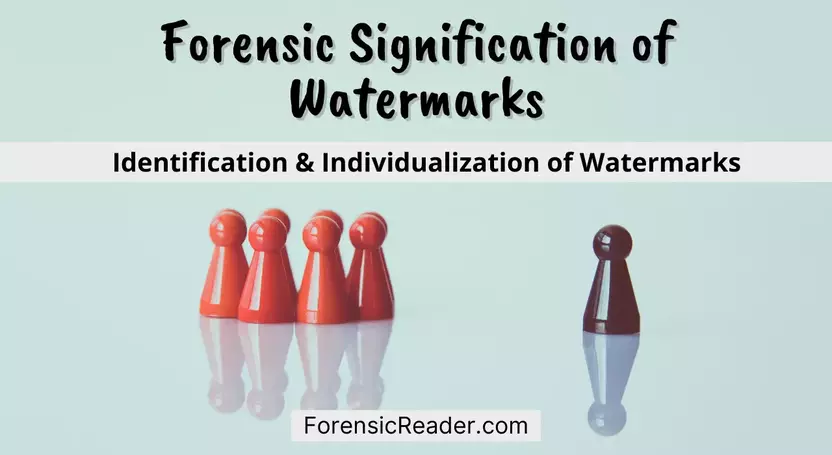Watermark is a distinctive form of image, shape, text, or any design that appears translucent and fainter when light passes through it.
When these watermarks appear in the questioned documents, they can state origin, manufacturer, retailer, and possibly the manufacturing date. Know more: Forensic Watermark Examination of Paper: Destructive And Non Destructive Analysis
In this simple post, I am going to state why watermarks are important in the QD examination and how you can differentiate between different types of watermarks. Please note, the following information must be used only for educational purposes.
Type of Watermarks Based on Their Appearance:
1. Localized Watermarks: Appears at a specific position of the page with definite intervals. No randomness is seen.
2. Random Watermarks: They are randomly placed on the page. It’s like randomly stamping. They are majorly seen in chemical watermarks that are manually marked.
Quick History: Watermarks used in Europe for the first time. They consisted of simple crosses and circles (Italy).
Types of Watermarks on How They Are Made

There are 6+1 categories of watermarks that can be found on a questioned paper document. These are:
- Physical watermark
- Chemical watermark
- Artificial watermark
- Shaded watermark
- Stamp Roll watermark
- Embossed watermark
- Digital Watermark
1. Physical Watermark
As the name said, these manufacturers are made during the manufacturing process. Other names for manufactured watermarks:
- Traditional watermarks
- Ture watermarks
- Patch watermarks (because a mark patch sewed over rolls)
It can be achieved by two methods: Dandy roll and cylinder mould.
A. Dandy Roll (Fourdrinier)
An image or pattern is first created on wire and then placed over the rotating dandy roller, which presses the pattern against the wet paper on the production line— similar to stamping a pad, but here no ink.
Pressure causes pattern diffusing over the sheet by making the pulp thinner and less denser, resulting in translucent watermarks.
Moreover, the extent of pressure is responsible for the watermark opacity.
Quick history: They were made by John Marshall in 1826.
B. Cylinder Mould
More clearer and detailing is seen in cylinder moulding watermarks. This can be achieved by 3D relief on the roller itself (not on the wire). This makes the watermarking more detailed.
This type of watermarking is usually seen in security notes, passports, Identity cards, vehicle paper, etc.
Quick history: They were first used in 1848.
2. Chemical Watermarks
They use specialized chemicals with a refractive index similar to cellulose and make impregnated areas translucent. These chemicals replace the entrapped air in localized areas.
Their concentration and composition determine the extent to which they can create opacity.
Traditionally, the flexo chemical watermarking technique was widely used. It uses flexo printing plates with translucent chemical polymers that on impart creates chemical watermarks.
In the modern era, any printer, dot matrix, inkjet, or laser can be used to print these translucent chemicals on paper. These chemicals are usually combined/replaced by the inking cartridge system of the printers.
Quick history: First chemical watermark patented by Frans V.E. Vaurlo in 1959.
Common Types of Chemical Watermark Reagents
a. Thermal Translucent Ink for Inkjet Printers
Composition:
- Polyethylene glycol: 79%
- Water: 20%
- 1-Methoxy propanol: 1%
- Triton X-100: Added till surface tension in between 27 to 30 dyne.
Procedure:
- Replacing the above composition with an inkjet ink cartridge.
- Print the pattern over the paper.
- Melting the polyethylene glycol, by heating the printed paper to 60° C.
- Melting soaked polymer into paper, resulting in a translucent area.
Remember: Dyne is a metric to measure the surface tension (dynes/cm). In printers, they are measured by applying wetting tension liquids to paper in order to analyze print-ability, coating lay down, and heat sealability of treated films.
b. Translucent ink Without Heat Application (composition)
- Disaccharide: 30%
- Water: 30%
- Triton X-100: 5%
- 1-Methoxy propanol: 1%
c. Oil Based Chemical for Watermarks
The most common translucent oil-based chemical is linseed oil, and here is the workable combination:
- Linseed oil: 40%
- Acetate: 30%
- Isopropanol: 30%
d. Translucent Chemical For Watermarking with Laser Printers
- Polyethylene glycol diacrylate: 50%
- Trimethylolpropane triacrylate: 47%
- C-Dimethylamino Deoxybenzoin: 3%
3. Artificial Watermark
They are different in the sense that they are only visible on one side of the paper— printed side— when viewed with an angle.
They are also called simulated watermarks (sometimes chemical watermarks too).
Like chemical watermarks, they are also embedded after the production of paper. They are created when a pattern, text, or image is printed with opaque, transparent, white, or using varnish-based ink.
Artificial watermarks are widely used to authenticate and identify secure documents such as banknotes.
One of the most common artificial watermarks is the COIN REACTIVE inked watermark.
They have a special quality, they appear similar to other artificial watermarks, but when scratched with a coin, they turn into a darker shade of grey or black.
4. Shaded Watermarks
They have distinctive shadow-edged watermarks and are called shadow watermarks.
Principle of development: it uses a special sheet that has a denser area where the design will impress than the rest of the paper.
Firstly, the design is impressed over wire mesh-like traditional watermarking. Then it is made to move manually over the specific area (denser).
Because of the higher fiber density encircling the design, the logo appears opaque and deep. And, the extent of pressure applied to the design area adds more depth to watermarks.
This depth is visible as a shadow in low degree illumination. It can also be felt by moving fingers over the design.
Quick History: The technique was developed by William Henry Smith in 1848.
Conversely, there is also a light watermark that has less density of fiber in the design area, results in light and a more translucent watermark.
5. Stamp Roll Watermarks
It’s the same as stamping paper. And also known as the Molette Process. All processes are the same, but with two differences; use a drier paper, and considerable high pressure.
Unlike the traditional watermark, which uses wet paper, here a relatively drier paper is used.
Paper is brought in between the arrangement of dandy rolls with stamp marks and supporting cylindrical drum. This replicates a translucent watermark over the sheet while maintaining sharp edges definition.
Key characteristics of stamp roll watermarks:
- a light line mark left on sheets.
- The design has sharp edges.
6. Embossed Watermarks
As the name suggests, these watermarks have a raised position and are commonly seen in questioned documents such as diplomas, certificates of achievements, mark sheets, etc.
Embossed watermarks involve processes of imparting the design when the sheet is nearly dry using an engraved (deep), in-steel roll compressing fiber.
The resultant watermark is not only translucent but also has a raised surface than the paper.
Key characteristics of embossed watermarks :
- Sharp edge like stamp paper
- A raised watermark on paper
7. Digital Watermarks
These watermarks are easy to make and very common. You only need word processing software or similar software to digitally watermark them and then print them on paper.
But they are not the actual watermark.
I would say, “they are a FALSE WATERMARK.” as no translucency is seen in them. They are just an overlay or overprinted form of pattern.
Forensic Signification of Watermarks: Identification and Individualization

Let’s look at how these types of watermarks aids questioned document examiners (QDEs) in their examination of the paper.
A. Forensic Significance of Physically Manufactured Watermarks
Watermarks made during the manufacturing process tend to differ microscopically with each press of pattern on sheets.
This is due to the fact that raised/intended designs tend to accumulate fiber at their edges, lowering the density of paper fiber in that specific area.
So, with each rotation of the dandy roll, the fiber accumulation increases, resulting in a relatively more opaque watermark (transmit less light) than the rest.
This problem is commonly seen in traditional watermarks, but much more common in a dandy roll. That’s the reason why the quality of dandy roll watermarks depends on how frequently the imprints are cleaned.
Furthermore, defects to these raised patterns are highly individualistic. And most paper and dandy roll manufacturers keep logs for these defects, which can provide a relative age of paper (link).
These three (fiber accumulation, defects, and logs) properties add additional identification markers to forensic document examinations. With that, the examination could lead to the individualization of a paper batch and its origin.
B. Forensic Significance of Chemical Watermarks
Individualization, and coming up with a smaller search group can be achieved with chemical watermarks.
These chemicals are very individualistic based on their composition and type of printing process.
The organic analysis and instrumental analysis (IR) can evaluate the groups that are involved. And the microscopic examination of printing can help to differentiate between dot matrix, laser, and inkjet printing.
Difference Between True Watermarks and Chemical Watermarks
Following are the features that are seen in chemical watermark only:
- Alteration in the surface and change in chemical composition of paper.
- Glossiness and brightness of the chemical watermarks differs when paper aged.
- The edges of chemical watermark smudges with time.
- Aged paper usually has more opaque/translucent marks than the rest of the paper.
- Difficulty/different shade in writing ink pens, pencils, typing, and print over the chemical watermark.
C. Forensic Significance of Artificial Watermarks
They nearly have all the characteristics of chemical watermarks with one exception.
They are primarily used to authenticate secure documents. Therefore, there is major significance in the detection of forged security papers and banknotes.
Moreover, they can also state the age of the document as most of the records such as a change in color, font, size, date, etc are maintained by the government.
D. Forensic Significance of Digital Watermarks
They are easy to make but harder to individualize. It can be misleading when intended with forged intention. Information that can be extracted from the digital watermark.
- Person and company to whom watermark refers to.
- Type of printing technology.
- Date of printing, or any reference date. Check how to estimate date of paper manufacturing using watermarks.
- Specific group of people who uses paid subscription or organization.
Digital Watermark Vs Manufacturer Watermarks— Which is better?
Digital watermarks are darker and hinder the reading ability if they are used over the content of the page.
On the other hand, watermarks made during the manufacturing process produce very light and diffuse marking that isn’t visible unless you see through a brighter background.
But they are not good for personal or small business use because you have to contact paper manufacturers for special orders (which are usually in bulk). And with digital watermarks, you just need word processing software to create and print them over the paper.
References:
- Scientific examination of questioned documents [Book]
- Watermarks by Piyel Haldar [source]
- A scientific method for forensic examination of paper [link]
- Everything you Wanted to Know About Watermarking: From Paper Marks to Hardware Protection [link]
- Forensic Document Examination: Fundamentals And Current Trends [Book]
- Forensic Document Examination: Principles And Practice [Book]
- Scientific Examination Of Documents Methods And Techniques [Book]

FR Author Group at ForensicReader is a team of Forensic experts and scholars having B.Sc, M.Sc, or Doctorate( Ph.D.) degrees in Forensic Science. We published on topics on fingerprints, questioned documents, forensic medicine, toxicology, physical evidence, and related case studies. Know More.
